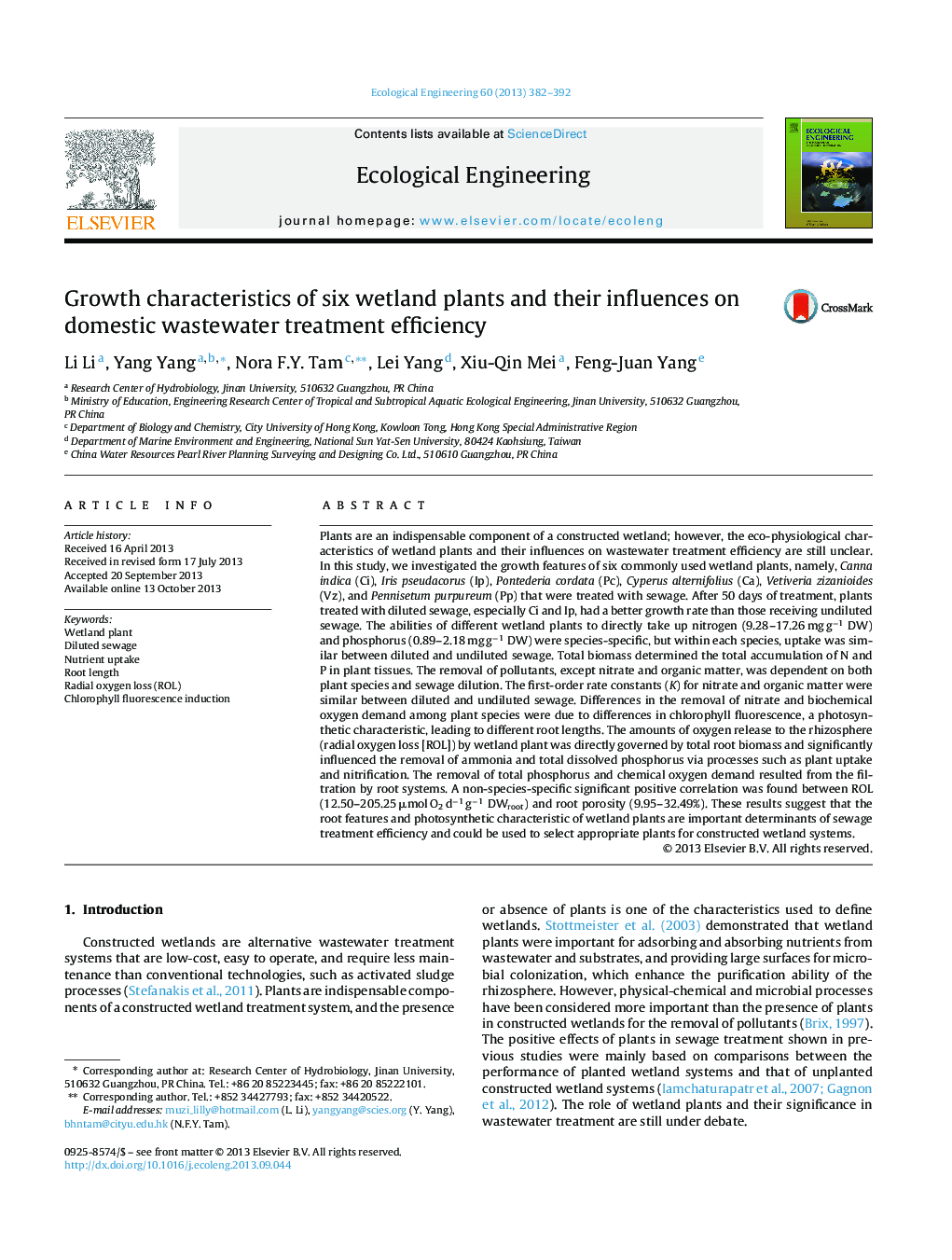| کد مقاله | کد نشریه | سال انتشار | مقاله انگلیسی | نسخه تمام متن |
|---|---|---|---|---|
| 6302442 | 1618038 | 2013 | 11 صفحه PDF | دانلود رایگان |
عنوان انگلیسی مقاله ISI
Growth characteristics of six wetland plants and their influences on domestic wastewater treatment efficiency
ترجمه فارسی عنوان
خصوصیات رشدی شش گیاه تالاب و تأثیر آن بر عملکرد فاضلاب خانگی
دانلود مقاله + سفارش ترجمه
دانلود مقاله ISI انگلیسی
رایگان برای ایرانیان
موضوعات مرتبط
علوم زیستی و بیوفناوری
علوم کشاورزی و بیولوژیک
بوم شناسی، تکامل، رفتار و سامانه شناسی
چکیده انگلیسی
Plants are an indispensable component of a constructed wetland; however, the eco-physiological characteristics of wetland plants and their influences on wastewater treatment efficiency are still unclear. In this study, we investigated the growth features of six commonly used wetland plants, namely, Canna indica (Ci), Iris pseudacorus (Ip), Pontederia cordata (Pc), Cyperus alternifolius (Ca), Vetiveria zizanioides (Vz), and Pennisetum purpureum (Pp) that were treated with sewage. After 50 days of treatment, plants treated with diluted sewage, especially Ci and Ip, had a better growth rate than those receiving undiluted sewage. The abilities of different wetland plants to directly take up nitrogen (9.28-17.26 mg gâ1 DW) and phosphorus (0.89-2.18 mg gâ1 DW) were species-specific, but within each species, uptake was similar between diluted and undiluted sewage. Total biomass determined the total accumulation of N and P in plant tissues. The removal of pollutants, except nitrate and organic matter, was dependent on both plant species and sewage dilution. The first-order rate constants (K) for nitrate and organic matter were similar between diluted and undiluted sewage. Differences in the removal of nitrate and biochemical oxygen demand among plant species were due to differences in chlorophyll fluorescence, a photosynthetic characteristic, leading to different root lengths. The amounts of oxygen release to the rhizosphere (radial oxygen loss [ROL]) by wetland plant was directly governed by total root biomass and significantly influenced the removal of ammonia and total dissolved phosphorus via processes such as plant uptake and nitrification. The removal of total phosphorus and chemical oxygen demand resulted from the filtration by root systems. A non-species-specific significant positive correlation was found between ROL (12.50-205.25 μmol O2 dâ1 gâ1 DWroot) and root porosity (9.95-32.49%). These results suggest that the root features and photosynthetic characteristic of wetland plants are important determinants of sewage treatment efficiency and could be used to select appropriate plants for constructed wetland systems.
ناشر
Database: Elsevier - ScienceDirect (ساینس دایرکت)
Journal: Ecological Engineering - Volume 60, November 2013, Pages 382-392
Journal: Ecological Engineering - Volume 60, November 2013, Pages 382-392
نویسندگان
Li Li, Yang Yang, Nora F.Y. Tam, Lei Yang, Xiu-Qin Mei, Feng-Juan Yang,
